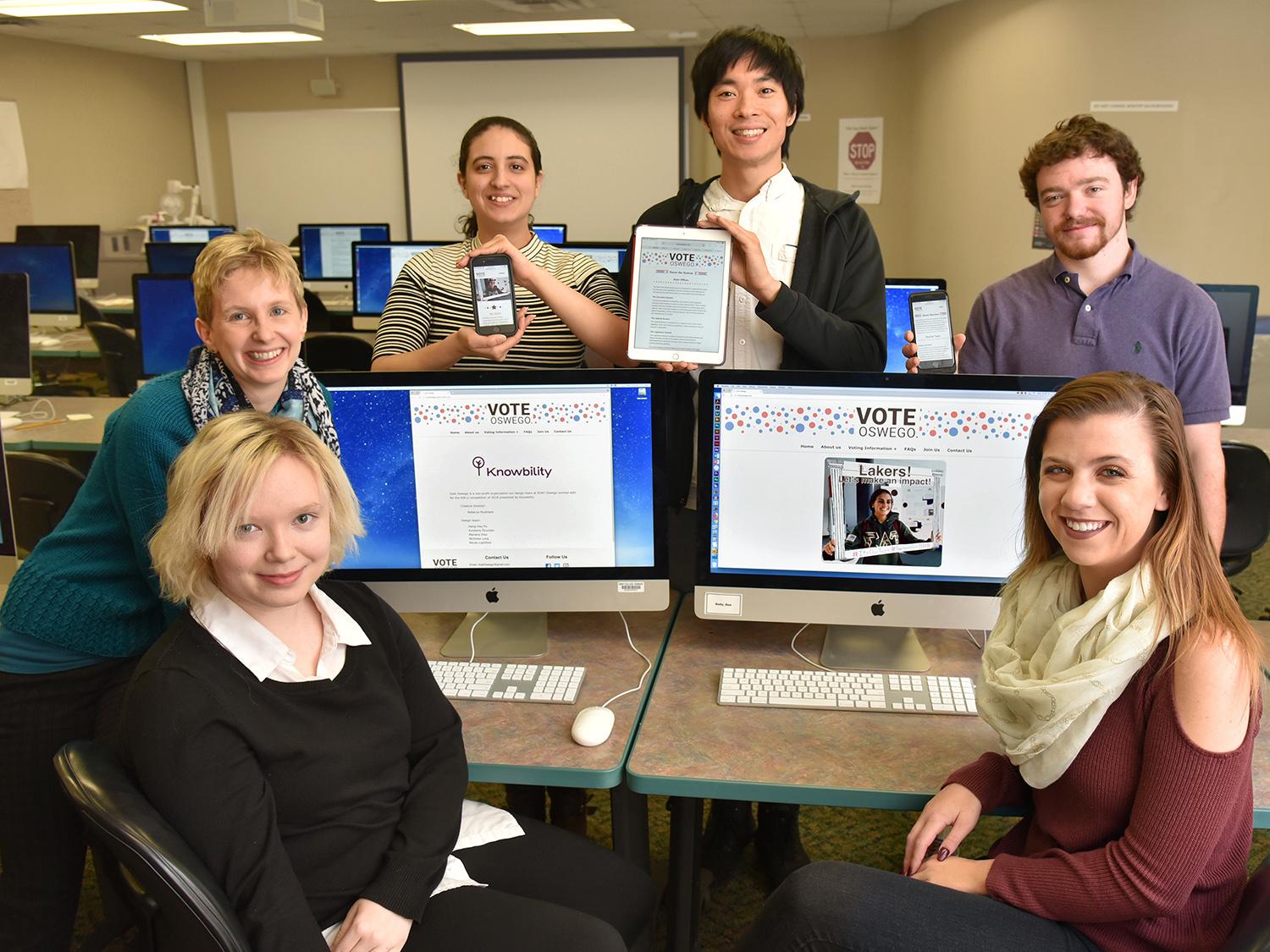Accessibility team -- SUNY Oswego's winning team in the national AIR-U competition for web design that's accessible to all users, including those with disabilities, displays some of the VoteOswego.com site. As mentor and instructor Rebecca Mushtare leans on the desk, clockwise from front left are students Kimberly Grunden, Mariana Diaz, Heng-Hao Pu, Nick Long and Nicole Lightfoot.
Five SUNY Oswego students under the mentorship of graphic design faculty member Rebecca Mushtare recently won the national AIR-U competition for accessibility in web design for the team's inclusive work on the Vote Oswego site.
Knowbility, an Austin-based nonprofit organization dedicated to supporting the independence in technology of children and adults with disabilities, sponsored the University Accessibility Internet Rally to encourage students to work toward a more inclusive digital web for all.
Mushtare served, essentially, as creative director of a team that included students Mariana Diaz, Kimberly Grunden, Nicole Lightfoot, Nick Long and Heng-Hao Pu. The team worked with a client, political science faculty member Allison Rank's "Vote Oswego" class, which promotes electoral and political participation by all, regardless of affiliation.
The AIR-U competition's judges provided feedback to entrants, and the Oswego team excelled in areas Mushtare focuses on in a course that combines "Web Media II" for undergraduates and "Graduate Web Design" for master's degree candidates.
"They thought the aesthetic and visual design (of VoteOswego.com) was great," she said. "Our team was making live revisions and updates to the site, and that was also noted by the judges."
While it takes work to make sure web content and design are accessible to people with auditory, cognitive, neurological, physical, speech and visual disabilities, the students on SUNY Oswego's team found it an enjoyable, motivating project.
Grunden, a dual major in information science and graphic design, said her biggest takeaway from the competition was in structuring the project as it might go in a professional setting.
"This was my very first client project in web design," she said. "I got a lot of experience in how the field works in the real world. I do think more people (in web design) need to focus on accessibility."
Leveling the field
Diaz, a graduate student in graphic design and digital media, explained that accessibility in design involves a variety of skills -- from coding to content editing to visual expertise and beyond. The team members benefited from Knowbility training in addition to their own coursework.
"In our HTML (hypertext markup language), we needed a clear heading structure that screen readers (for the visually impaired) could follow," Diaz offered as an example.
Long, a senior in SUNY Oswego's bachelor of fine arts (BFA) graphic design program with an emphasis on illustration, said color contrast is crucial for web readability, so that colors don't blend together, such as with a gray-on-gray design. He also noted that, due to the nonpartisan nature of Vote Oswego, the balance of reds and blues was crucial -- that concern affected the visual imagery, including selection of images (not too many red or too many blue sweaters) and working with Rank's class to rewrite content that might be perceived as indicating political bias.
Pu, a graduate student in Oswego's human-computer interaction program, said he found the creative-team model -- working with a diverse group of students with different majors and perspectives -- made the process better than it might have been as an individual designer or coder. "We had to work to resolve our (creative) conflicts," he said.
Lightfoot, a December graduate in the graphic design BFA program, said the project helps advance her plans for a career in user-experience design.
The students' mentor, Mushtare, recently was among the 13 winners of $5,000 Curriculum Development Awards available to instructors at colleges and universities nationwide. Her project, "Fully Integrating Accessibility into Web Design Courses," involves developing new exercises, demonstrations and videos in collaboration with a disability advocate and assistive technology expert to enhance the way she teaches accessibility and inclusive design. Diaz has been working with her on the initiative.
"I really liked doing the (Vote Oswego) project with a small group of advanced students," Mushtare said. "It's nice to see the team gel and work through issues and come to resolutions."
SUNY Oswego recognizes that digital accessibility is essential to ensuring equity and inclusion, and understands that infrastructure and faculty support are needed to engrain accessibility within the fabric of the college.
To learn more about graphic design, information science, human-computer interaction or any other of the college's more than 120 major programs of study and 70-plus minors, visit the SUNY Oswego programs page.




